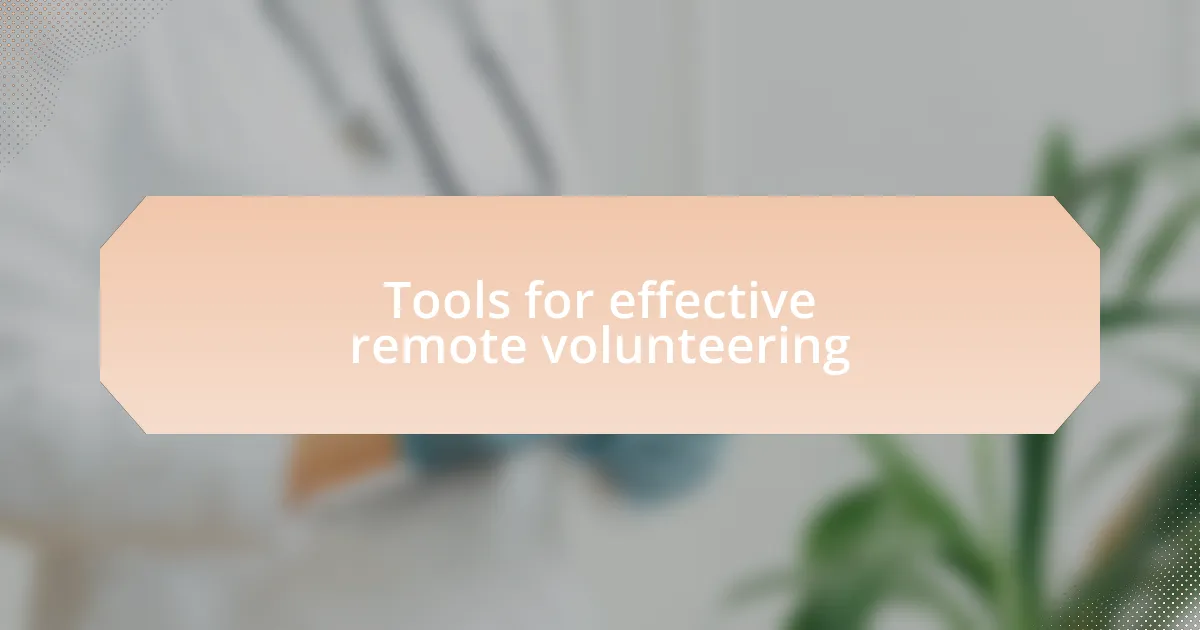Key takeaways:
- Volunteering in hospital ministry offers diverse roles, from patient interaction to administrative support and virtual assistance.
- Remote volunteering allows individuals with mobility or time constraints to contribute meaningfully from home, fostering connections and community.
- Key remote ministry types include virtual chaplaincy and online grief support groups, both essential for providing emotional support and social connection.
- Effective remote volunteering relies on tools like video conferencing (Zoom), collaboration platforms (Slack, Microsoft Teams), and social media for outreach and sharing experiences.

Understanding hospital ministry volunteering options
When considering options for volunteering in hospital ministry, I’ve found that there’s a wide variety of roles available to fit different interests and skills. For instance, some volunteers might enjoy spending time with patients in a friendly chat, while others may find fulfillment in providing administrative support to hospital staff. Have you ever thought about where your strengths could be best utilized?
One of my memorable experiences was volunteering to coordinate a small group that delivered care packages to patients. This allowed me to connect with individuals, listen to their stories, and offer them a bit of joy during tough times. I realized then how powerful even the smallest acts of kindness can be in a hospital setting. What might seem insignificant to one person could mean the world to someone else.
Another option that often gets overlooked is virtual volunteering. In today’s technology-driven world, providing support via phone calls or video chats could be just as impactful as in-person interactions. Have you considered how your conversation might brighten someone’s day from afar? This flexibility allows more people to get involved, regardless of their physical location.

Benefits of remote volunteering
Remote volunteering offers incredible flexibility, allowing you to support hospital ministry on your own terms. I remember a time when I assisted with a virtual prayer line from my home. It was rewarding to connect with individuals who needed spiritual encouragement despite the distance. Have you ever thought about how a simple prayer could bring comfort to someone in a hospital bed?
One of the most beautiful aspects of remote volunteering is the ability to reach those who may otherwise feel isolated. I once hosted an online support group for caregivers who were overwhelmed by their responsibilities. Their gratitude reminded me that providing a listening ear, even through a screen, can foster a sense of community. Isn’t it fascinating how technology can bridge gaps and provide companionship in times of need?
Moreover, remote volunteering can be a game changer for those with limited mobility or time constraints. I’ve met several people who wanted to contribute but found it difficult due to travel challenges. By volunteering remotely, they could share their unique gifts from the comfort of their home. Doesn’t it feel great to know that every skill, no matter how small, can make a significant difference?

Types of remote hospital ministries
Remote hospital ministries come in various forms, each uniquely designed to address specific needs within the healthcare community. For instance, I’ve participated in virtual volunteer chaplaincy programs where volunteers provide spiritual care and emotional support to patients and families via video calls. It was deeply fulfilling to share calming messages and prayers with people facing difficult health battles, reminding me of how a few compassionate words could bring light into a dark situation.
Another type of remote hospital ministry I’ve encountered is the online grief support groups. Facilitating these sessions allowed me to create a safe space for individuals processing loss, regardless of geographical barriers. The raw emotion expressed in these groups often left a lasting impression on me, as I saw participants find solace in sharing their experiences with others who truly understood their pain. Have you ever experienced the healing power of shared vulnerability?
Additionally, many organizations are utilizing technology to run virtual workshops that educate patients and caregivers about coping techniques and wellness practices. In one workshop I attended, therapists taught mindfulness and relaxation strategies that could be easily incorporated into daily routines. The transformative feedback from attendees was a stark reminder of the profound impact that knowledge and support can have, especially when traditional in-person interactions are limited. Isn’t it inspiring to think that we can equip others to navigate their health journeys remotely?

Tools for effective remote volunteering
When it comes to remote volunteering, having the right tools can make all the difference. One of my favorites is Zoom, which I’ve used extensively for virtual meetings and support sessions. It creates a sense of presence, allowing us to connect meaningfully despite physical distances. Have you ever felt like a simple video call could bridge the gap between loneliness and connection?
Another essential tool is online collaboration platforms like Slack or Microsoft Teams. These are great for maintaining open lines of communication and sharing resources with fellow volunteers. I once worked on a project via Slack, where we exchanged ideas and encouraged each other. It turned a daunting task into a team effort, which was incredibly motivating. Doesn’t it feel wonderful to be part of a supportive community, even when you’re apart?
Lastly, I can’t stress enough the value of social media for remote volunteering. It’s not just a way to spread awareness; it can also be a platform for sharing personal stories and inspiring others. I vividly remember posting about a health awareness campaign and getting responses from people I had never met. Their gratitude reminded me that we can have a powerful impact just by sharing our journeys. Isn’t it incredible how a simple post can resonate with someone far away?